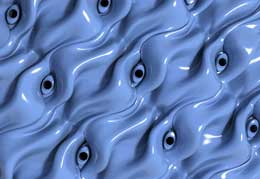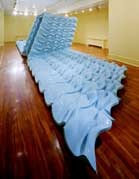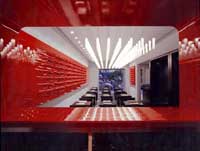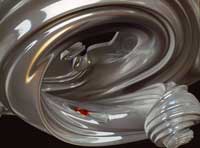New York architect Evan Douglis explores the generation of changeable environments supported by digital techniques. Auto Braids / Auto Breeding is a membrane manufactured with 3D modeling software and five-axis prototyping milling machines.
Composed of interlocking units, the membrane features pockets for the placement of poles that support other objects away from the surface.


Thanks to casting technologies employed in product design, the membrane gives a physical body to images that are usually associated with the virtual world. Lacking a definite dimension and orientation (except for the ones given by the surrounding environment), Auto Braids / Auto Breeding is an evolutionary architecture that constructs a continuously shifting environment able to respond to the spreading of information flows.
Auto-Braids / Auto-Breeding opens new perspective on the future development and application of “biological mimesis” for architectural production. As we enter through this new phase of morphogenetic and technological expansion we unleash a range of material and programmatic opportunity capable of altering the very destiny of architecture.


Check also Douglis other works: REptile–Haku installed at a Japanese Restaurant in NYc. To create the wall tiles, the architect deployed digital technologies of design and mass production, using a limited number of parameters to produce great variety. Through biological mimesis, the spiky, undulant surface evokes characteristics of the reptile, a creature of mythological status in Japanese culture.
For the Helioscopes project, fiberglass-resin spirals would hang from the ceiling, forming viewing booths, where visitors, each wrapped by a helical tail, could watch video displays. The footage presents multithemed Japanese Love Hotels, offering an implicit commentary on architecture as fashion commodity and food for fantasy.
More in Arch’IT. Slideshow in Architectural Record.
